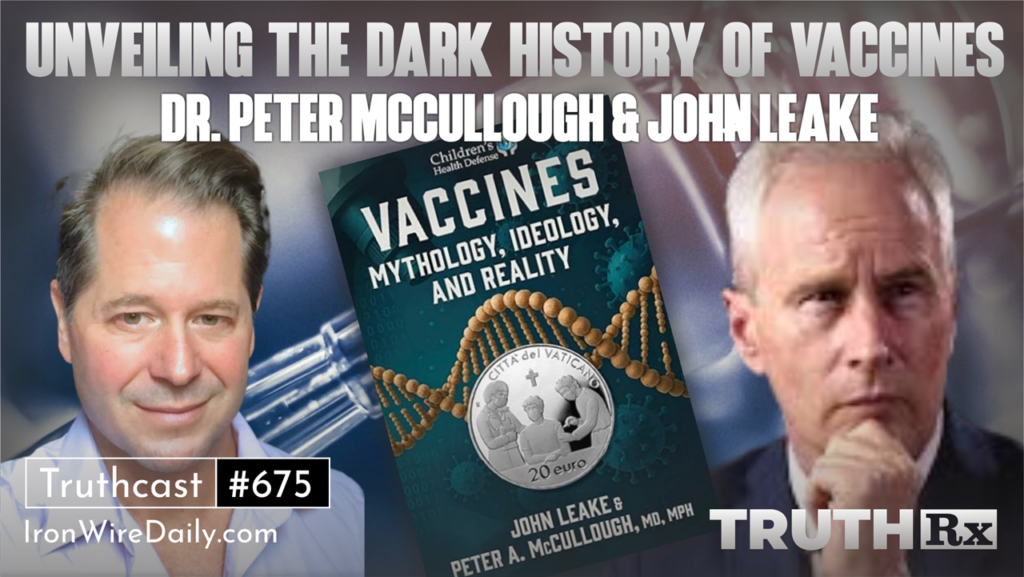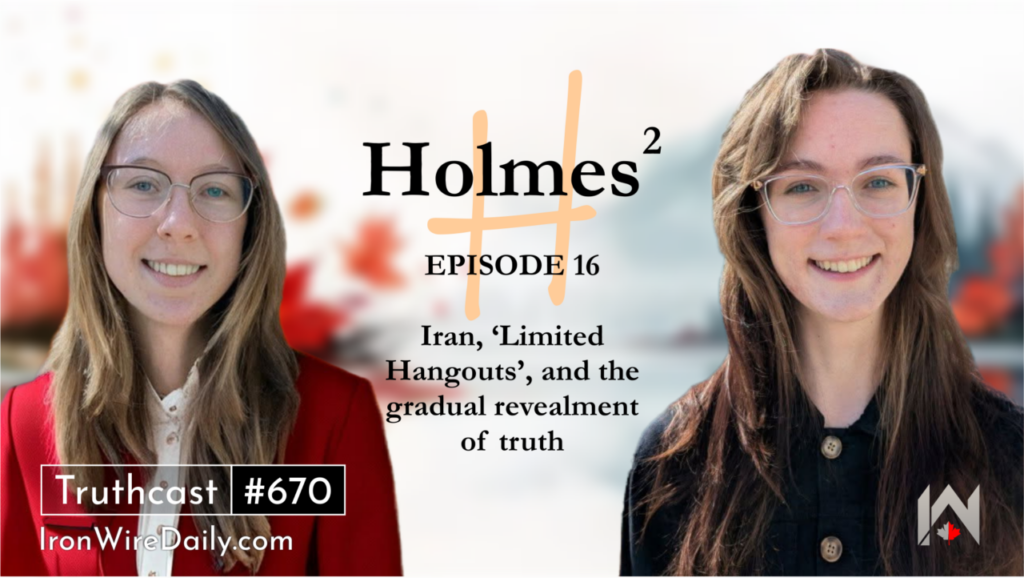Episode 5: “Molecular Chaos Following mRNA Injection”
With Dr. Peter MuCullough and Nicolas Hulscher, MPH
In a groundbreaking discussion hosted by the McCullough Foundation’s Focal Point podcast, Dr. Peter McCullough and epidemiologist Nick Hulscher welcome Dr. John Catanzaro, a leading researcher from Neo7 Bioscience, to unveil alarming molecular findings related to mRNA vaccines and long COVID. Through their collaboration with the University of North Texas Genomics and Biodiscovery Institute, Dr. Catanzaro’s team has developed the REVIS system—a cutting-edge RNA Expression Variant Instability Signature Surveillance tool. This technology reveals disturbing patterns of genetic dysregulation in patients, including those vaccinated with mRNA boosters and individuals suffering from long COVID, shedding light on the profound impacts of synthetic spike protein exposure on human cellular machinery.
Dr. Catanzaro’s research dives deep into the molecular consequences of mRNA vaccines, identifying unfavorable gene expression, immune suppression, hyperinflammatory responses, and oncogenic shifts that may contribute to aggressive cancers like glioblastoma. With compelling data from real patient cases, including those referred by Dr. McCullough, the discussion explores how synthetic elements, such as spike-linked fragments and potential ribosomal frameshifting, disrupt critical housekeeping genes. This interview not only highlights the urgent need for precision detection and mitigation strategies but also offers hope through Neo7 Bioscience’s personalized peptide approaches, aiming to recalibrate immune responses and restore cellular balance in affected individuals.
LINK: Neo7 Bioscience – https://neo7bioscience.com/
(0:01 - 1:35) Welcome everybody to Focal Point and McCullough Foundation-sponsored podcast. Today we have Dr. Peter McCullough, but our special guest here is Dr. John Catanzaro. He has uncovered some alarming findings regarding, he's looked molecularly at mRNA-boosted individuals, as well as long COVID patients. So, Doctor, why don't you tell us a bit about what you've been doing, what you've been looking at in these individuals. Yes, thanks for having me on, Nick, and thank you, Peter. Neo7 Bioscience has been working with UNT, University of North Texas Genomics and Biodiscovery Institute, and we have been uncovering some pretty alarming data, as more and more data is coming in, obviously. We have a system called REVIS, and REVIS basically is a transcription instability scoring system, and we get to see the associations with the mRNA vaccine-related complications in the data sets of real patients, and we have our findings here on that little slide deck that I can go through with you. All right, yeah, let's pull that up. Well, and let me add my welcome, John, Dr. John Catanzaro, to Focal Points, along with Nick Hulscher, McCullough Foundation epidemiologist. (1:35 - 5:57) John and I have had a show together, lots of interaction, and Neo7 Bioscience is clearly the leader in giving us molecular understanding of what's going on in this new world of people who have taken genetic messenger RNA vaccines, and in fact, John, I think, are you going to show some data from at least one of my patients, right? Yes, we've got, we have a pool here, a pretty nice slide that kind of explains the case, the individual cases, but what we've done is we started a program over at UNT. It's called Genetic Safety, the Genetic Safety Program, and we have been working together to develop this technology to allow for a better precision detection of aberrant signaling, right? So what you see here is revus molecular surveillance, post-vaccine and long COVID signal disruption. Basically, we're interrogating hallmark pathways, immune instability, and oncogenic activation, which simply means cancer-type signaling that causes progression in the patient's data set. So we basically, REVIS stands for the RNA Expression Variant Instability Signature Surveillance, that's what that is, and as I mentioned, we, you know, are doing it under the Genetic Safety Program, and what it does is it combines the transcriptomics, which is actually how the message is being typed in the system, basically, in relation to the exposure to spike-related synthetic signatures, and what that effect is on the overall housekeeping system, basically, right? Because we have housekeeping gene proteins that are supposed to be keeping regular homeostasis and balance to where we have a even signaling, and basically, what we're using is an augmented hybrid intelligence platform that allows for us to map a systemic molecular instability, and we're looking at some pretty serious cases, as you mentioned, Peter, where, you know, one of your patients is in that mix demonstrate, you know, the data of unfavorable aberrant-type signaling. So what we got, basically, you know, I don't like doing PowerPoints so much, but we have to kind of, you know, list this out because it's pretty important. When we're looking at the whole process, we're quantifying the signal-based molecular aberrations in these patient samples, and we're looking at the unfavorable gene protein expression, which actually is a facilitator of poor protein-to-protein interactive crosstalk in the body systems, and it's in relation to the synthetic RNA contamination, which actually not just causes immune dysregulation and immune suppression, but it also creates hyperinflammatory responses, which we see in these regulatory genes, and oncogenic shifts. So the oncogenic shifts basically mean that tumor suppressors are inhibited, tumor promoters are accelerated, and you get a flip that happens in that whole process, which is quite alarming, right? So I don't know if you can see this. This is a little bit of a figure here that kind of goes into case zero. Case zero, we're still working on statistical expression, but what we have so far is the 2.5% expression is a normal expression where you can see that pi on the left-hand side on the very first pi, case zero, that the majority of that pi is in a favorable expression, right? And then we have a patient that's a long COVID patient that has never been vaccinated, and this patient here is demonstrating the percent that you can see there, which I believe is like a 20%, or I can't, you know, I can't see it really good because it's kind of small, but you can see the percentages there of unfavorable expression. (5:58 - 7:00) Case two is vaccinated and boosted. So in other words, they received one vaccination and one booster injection, and then case three was just vaccinated with no boost, right? Now explain to our audience what that means in layman's terms, like what does it mean when somebody will have unfavorable expression, and what is spike-linked synthetic elements? Okay, so the unfavorable expression is basically the hallmark genes of good housekeeping in the system molecularly, right? So in other words, these gene proteins are responsible for keeping good molecular transcription and translation. That means that things are, you know, coordinating and the feedback systems are intact, okay? So when you start seeing more red signatures in that first bar graph, that's demonstrating that the patient's data set is revealing a differential expression that's showing dysregulated or deregulated type expressions, okay, in those housekeeping genes. (7:01 - 7:53) And then the second one is what you see, the black bar graph there is basically the spike-X-linked synthetic elements. So like, for instance, we see fragments of poly-A tails, MT12S subunits. We see globin fragments, you know, the globin fragments we're seeing on, you know, in the data sets. We're seeing contaminants that are fragments of proteins that should not be there, okay? So, and these fragments of proteins are not just necessarily a long segment of spike, though they're portions of a spike fragmented and other things with it, contaminants, toxins. Well, John, in addition to contaminants, could they represent frameshifted peptides? Yes, absolutely. Ribosomal frameshifting could actually create more of these fragmented structures, right? And that's what we're seeing. (7:54 - 8:22) So, John, let me get this straight. So at the top, is that represent a patient who's not had COVID and not had the vaccine? Yeah, that's a normal, that's a normalization right there from the patient that's pre-COVID, from patient data set that's pre-COVID. So it's a virgin patient, and almost all the gene expression there is kind of normal, kind of global gene expression is normal. (8:23 - 8:47) Then the next case down, the next case down, is that a patient who's had COVID or the vaccine? That's a patient that's had COVID more than once, but no vaccine. No vaccine. So, John, if a patient has had COVID, so the second patient on the second line has not had the vaccine and has that degree of abnormal gene expression as shown in that kind of yellow orange. (8:50 - 10:25) John, what is the hypothesis going on there with respect to spike or integration of the virus into the human genome? What's going on? You know, we suspect that the viral integration for spike, for synthetic virus exposure, is different than the rhythm that you're seeing in case two and case three, which is mRNA vaccine-related spike activity, right? So there's a variance between the two. So the signaling that you get directly from the synthetic spike is not synthetic viral SARS-CoV-2, not related to mRNA vaccine, is you get a less of an apparent signature. But nonetheless, I mean, you're still getting a pretty significant portion of the pie being affected there, you know? But John, if we stay in case two, this patient had COVID a few times, has this degree of abnormal gene expression, could it all be driven due to retained spike protein, or does this imply that there is a subclinical SARS-CoV-2 replication still going on? No, I think it's the second part that you mentioned, Peter. I think it's a retention. I think it's a retention in the tissues that's allowing for a transcription, continuous transcription instability. So a retention of the live virus that's still in tissues? A retention of the spike that's coming from that live virus. (10:26 - 11:45) Oh, okay. So what is it about spike itself that influences gene expression? Well, it's a nucleotide segment that actually will be then incorporated into the cellular machinery. As you know, the ER is responsible for the packaging material, transcription, translation. And what winds up happening is because the protein in itself is an unstable protein, it creates that instability and ribosomal frame shifting, as you mentioned earlier, and we see that with the SARS-CoV-2 viral-related spike, but we also see it even more so, more seriously with the mRNA vaccine-related spike segment. Okay. Right. So now, and this patient here is just seen in case one after case zero, which is a normal case. Case one is basically saying, basically showing us that this patient was never vaccinated, never boosted, just had several bouts of COVID. So the vaccinated, the majority of gene expression is abnormal, more than half. (11:46 - 13:05) Yes. And that's what's so alarming because we're seeing this relationship here. And if you go over to the synthetic element relationship, you can see the bar black there, basically showing you that the synthetic element presence is there. We can detect it quite regularly in these patient data sets. And then you move over to the oncogenic shifting, the aberrant controls there, and you can see the purple bar basically is demonstrating a pretty significant alarming pattern of accelerated type signaling that you don't want in oncogenic signaling. And is this from peripheral white blood cells that are harvested from the patients? This is actually basically systemic blood, red blood, just regular blood, and high-definition RNA transcriptomics with, like I mentioned, high definition. So we're actually getting all the data points and all the data expressions from it, from the blood, peripheral blood. It would include all the white blood cell lineages, right? Because they have DNA. And then obviously the red blood cells and platelets don't have DNA. (13:06 - 15:09) But these are from living human cells. Living human cells, yes, real patients. Living human cells, real patients that are actually coming to Neo7 for mitigation strategy. Right. This is, I have to tell you, as a clinical doctor, who's referred some patients to your program, this is a stunning and actually very, very alarming data, John. Very alarming. When we first saw it, Peter, it was just like, whoa, our mouths dropped because we're just seeing the relationships there. And I just wanted to show you a case one glioblastoma case. So we got into a little bit more of the meat and potatoes here of what we call the TTIS. That's the score of the Revis score. And what you can see, again, it's 2.5 normal. And as statistical data comes in more, we're going to get, you're going to see some changes in the data to get what we call statistical expression. Because the more population data you get, then you're going to be, we're going to really start to see patterns solidified. But here we have, if you look here, you've got a relationship where we've got a significant portion, a percentage of the unfavorable barren activity with relation to the genes that are controlling transcription translation relationships in neuroinflammatory responses, mitochondrial controls, oncogenic shifting, and flipping, as well as things that affect the microbiome, by the way. So looking at endothelial inflammatory responses, that's when we talk about clot formations and tissue destruction and all those things. These red bars are very alarming. Okay, this is a glioblastoma case. This case right here is a healthy male, never had any type of cancer, no inherent risk, none of that, right? Physically fit and a raging brain tumor. (15:10 - 16:20) He got a booster, he got an mRNA shot, is that right? He had two shots. Yep, two shots. Two shots. And so the reference on the left is just, that's pre-pandemic again, that's a reference data set. Yes, that's a reference data set. And then the second is the patient data set, where you see the unfavorable shaded pie in the red. And then you get to see the housekeeping Hallmark gene expressions in each individual one of the Hallmark gene categories, right? I wish it was a little larger so you can see it, but they're broken down into mitochondrial dysfunction, neuroinflammatory, oncogenic, potential DNA repair issues, gastro microbiome disturbances and inflammatory endothelial dysfunction, right? So you got all of that stuff in there. And then case two, another GBM case. As you can see, the significant portion of the pie again is red, right? A little bit of a difference in this patient because he's got a pretty good favorable microbiome activity, but the rest of it is in the red and pretty high depth red. (16:21 - 16:34) And how many shots did this guy receive? He received two as well. And what was his diagnosis? Glioblastoma. Oh, so there's a second glioblastoma case. (16:34 - 16:44) Two in a row. We actually have four more. Yes, four more that just came in and all of them are mRNA vaccinated. (16:47 - 17:30) That's worrisome. It is worrisome. So when we look at it, which is, you know, if you look at this slide here, it's talking about looking at the core Hallmark expression gene proteins and their signaling relationships. But the other thing that we looked at is structural signaling, the collagens, laminins, and the regulation mistranslation issues. So when we talk about like, you know, when you remember that post you had out there with the, on autopsy, there were, you know, very big, large fibrous ships and clumps and, and bad, you know, tissue, pretty much destroyed tissue, fibrous clots and tissue strands. Well, we're actually seeing those signal controls here being strongly influenced negatively. (17:31 - 18:14) And then overall ribosomal instability and the mistranslation and, and, and folding. Proton folding. So, well, so let's go back. So, so you think those white fibrous clots aren't due to misfolded amyloidogenic proteins? Yes, they're related to collagens, laminins, you know, when the body's laying down a process to where it's trying to repair itself, it's, it's developing fibrous tissue. So it's replacing scar functional tissue with scar like tissue, right? And then you're seeing organs affected by that. So you get these real big, strandy pieces of tissue. (18:15 - 18:36) And that's basically resulting from structural signaling and collagens and laminins. It makes sense that it would be more than just amylogenic spike. There couldn't be that much spike to make a giant clot, but there could be that much collagen and laminin to do so. (18:37 - 22:03) Just, just from a quantitative perspective. Yes. And you see that relationship there because when you have that continuous transcription, translation and repeat, where you see that those proteins are, and the protein folding characteristics are chronically being assaulted, then that's where that, you know, it becomes, like you said, a global, a global movement in aberrant activity. So, and here we see, I'm just showing you this slide of where the dangerous flip is. We're talking about dysregulation or deregulation of TP53 and some of the, you know, real heavy hitters like the BRCA complex and RB1. And then you get activation of proliferation migration type gene controls, like a Mike, KRAS, the BCL2. These are heavy hitters. And when you're looking at this, this oncogenic switching and mistranslation is, it's, it's, it's a raging fire, right? So that's what we're seeing. And then you guys found this, you guys found that it does indeed dysregulate these, these, these key regulators. Exactly. That's consistent, right? That's consistent with the literature that shows that spike does, does dysregulate these. Yeah. And it's, it's kind of, the tumor suppressors are no longer doing their suppressing, suppressor job and the tumor promoters are accelerated. And then the other thing is, is a switch role environment. And I mentioned to Peter once before about the switched role environment to where tumor suppressors become promoters and tumor promoters don't, they, they are, they, they are quite more upregulated. So John, would this explain this phenomenon, what we call turbo cancer, where a patient has a known cancer and it seems to speed up in its progression after vaccination. So you think the inhibition of these tumor suppressors and potentially conversion of tumor promoters is explanatory? I think that it's, I think it's one segment in because there's the other part where you have the cancer cell proliferation signals, which is another thing that's involved in the process too, which we do see some more cancer, cancer proliferators. We see M1, M2 imbalances in the macrophage relationships that are just, that are disrupted significantly, which affect the formation of a tumor microenvironment, as you know. So yes, very much. I had a patient this week who has had multiple cancers, you know, kidney cancer, melanoma, you know, I think it was colon cancer. It just kept going and going. So, and this, some of these occurred before the vaccine. And so my thought was maybe there was a loss of function mutation in one of these tumor suppressor systems at baseline that was so permissive in terms of oncogenicity in this patient. Then they take the vaccine, they get spike protein, and they're already knocking down a weakened tumor suppressor system. And now the cancer is like wildfire. Yes, yes. That's, that logic is, you know, that forms, that's exactly what we're seeing in the progressive data analytics, is that we see those relationships just as you, just as you framed it. (22:03 - 24:04) And John, which one of these systems could be potentially influenced by SV40 or simian virus 40, the promoter, enhancer, and origin of insertion? Well, I mean, you know, when we talk about the plasmid relationships in SV40, which you, that in itself is like a high transcript influencer in itself, right? Because it's affecting DNA expression and, and DNA becomes very disoriented. And that's where we are doing some more study on, you know, what are these synthetics elements and contaminants and what, what, what exactly do they do in their crippling effect in, in the cellular machinery itself? So it's, it's early in the, in the data collection to know that, you know, solidly, but we're getting some, some glimpses of, you know, these fragment tails, for instance, coming in and creating some significant, you know, code disturbances on the proteins themselves. So I think that the contaminants and SV40 is a very large player in creating some significant DNA instability. Well, John, John, I wanted to just briefly mention this study here that confirms all of this, where, where they followed pancreatic cancer patients before and after the vaccines. And those who got three mRNA boosters had lived half as long and had a four times risk of death. So you think your, your data is in line with this? Yes, I really do. Because when you take a look at, you know, look in simple terms, if you look at a pie and you got more than half of your pie in the red, that, that is a significant, that is really, that's worrisome, highly worrisome, highly alarming, because we can't possibly regulate in functional capacity with half of our, half of our housekeeping genes deregulated and affected this way. Yeah. So very, very bad, bad news, bad news. (24:05 - 25:33) Well, well, the good news part of it is, is that we're, we're also working to address the mitigating strategy of helping to recorrect these dysregulated proteins. So like in other words, we have a spike mitigation strategy that, that takes the recepting, the receptor binding domain, the highly, the highly mutable receptor binding domains of spike. And we modeled it to be resilient in any transformation of a spike receptor binding domain. So our team, what we've done is we've modeled a peptide mitigation strategy that addresses a broad spike mitigation, right. And then we also, at the same time, address the personalized targets of the patients that are expressing dysregulated immune activity, as well as hyperinflammatory responses to mitigate against that and to help reset it. So, and these are personalized and precision strategies that are designed specifically for the patient. So that's the good news. That's the good news. Like, you know, but can, you know, can we get it in there in time to help these people? Because once that acceleration is happening, you can see it's, it's a, it's a, it's a raging fire, as we said, and it's a race against the clock because these people that have GBM, they were diagnosed within nine months of receiving vaccine. (25:34 - 27:03) And booster, boosters. So that quick, that quick. And so, so you, you're, you're developing ways to kind of ameliorate this in these patients. Have you treated any of these patients with these glioblastomas? We're starting, we're just starting with the ones that are related to vaccine, mRNA vaccine-related complications. Well, we do definitely look forward to seeing those results. Very important. Well, we're targeting specifically for immune recalibration and oncogenic suppression, right? We're also restoring immune transcriptional and mitochondrial balance. So we're hitting that reset button by personalized sequences matched to the patient dataset that are specifically related to the spike-related changes. And we're actively looking more specifically as what Peter was mentioning on specific fragments, including the SV40 relationships and how, what is it, what is it real, exactly doing in the cellular machinery, on the ER, you know, in the nucleus? These are things that we want to get more precise about, but we do see overall that they are significantly changing the cellular, the cellular health picture in favor of, you know, cells not being resilient. (27:04 - 28:07) So, John, when you've administered your treatment to try to mitigate, have you had a chance to reassess the gene expression in a resampled blood sample? Yeah, we're, we're, we have that in the plan, Peter. And we, we've been doing that with cancer. So like, for instance, we can track the, the Revis responses to the targets that, like, for instance, on our, we have one cancer patient that has a dual cancer that's a melanoma and a prostate cancer, and he did a year's worth of treatment, and he went into complete remediation. And we did a follow-up Revis on him, which looks at the, you know, transcription, translation stability, and we found a dramatic improvement in those, those, those targets that were selected that were highly resistant in his cancer. In other words, he had improvement by dramatic margin, by over 80%. Yeah. (28:07 - 28:51) Wow. So when you see changes, it sounds like they're pretty easy to see. They're not like little subtle fractional changes. If you swing the, the cellular molecular biology. Yeah, that's correct. Favorable direction, you'll see a lot more favorable gene expression, right? Yes, you will see a lot more favorable. You are, you are getting somewhere. So you, you know, when you hit those targets, those, those resistant targets, like in cancer, especially like a dual cancer expression, you're hitting those, you're hitting those resistant targets with the matched engineering to that specific target, right? And when we do these cancer patients, it's a multi-targeted approach. So we're, we're choosing 10 personalized targets. (28:51 - 32:30) So it's a multi-pool targeted approach, and we're hitting all of those targets. And then on REVIS, on the repeat REVIS, on this particular patient, we got to see dramatic improvement on all of those targets. And we had one target that was resistant still. So in other words, we did, we saw it was still neck and neck on the bar and we just thought, Oh, that's interesting. It was like a tub eight gene protein signal that just didn't budge, but everything else did. Those other nine targets significantly changed dramatically. Now, John, when you're treating a cancer patient and you want to assess if they're responding, do you have to keep re-biopsying the tumor or can you rely on the peripheral blood and serial sampling to, to, to know if you've had a favorable change? Yeah, you could rely on the peripheral blood and the CT DNA signature, right? So we actually have it down to where our peripheral blood RNA expression and CT DNA coordination, and then we compare it to the previous dataset. And very rarely do we have to get another biopsy to compare, you know. Wow. So this is, this is breakthrough for advanced cancer patients. They've tried everything. They ought to seriously take a look at Neo7 Bioscience, visit their website, contact Dr. John Catanzaro, who's made massive progress in this field. He's tackled some of my more difficult cases. One of the cases that I sent him was a man who developed throat cancer after taking a COVID-19 vaccine. Fortunately, I diagnosed it quickly and we got him a very good treatment, and right now he's in remission. But John, you said his signatures are still worrisome for oncogenic dementia. Yeah, they are. And what we need to do is, you know, we have a mitigation strategy that we designed for him, and he's waiting for his personalized drug to come. So, you know, that'll be coming probably in the next few weeks. It's already in manufacturing. So we, you know, and we're confident that we're going to, you know, see some significant changes for the better in that signaling platform that we, you know, that his signature. We should be seeing that red part of that pie turn more green, right? Yeah, that's what we want to see. And he's been zeroing in on his spike antibody levels, which I've told him, you know, it's just a surrogate for the spike mass that we need to use other parameters. Nick and I are having some experience using the INMODIA lab in Germany, where there are ELISA4 spike in the blood. I don't think it's very sensitive, so they're not picking up spike in blood very commonly, but they are finding intracellular spike, intracellular messenger RNA for Pfizer and Moderna, as well as SV40. And so this is, sadly, you know, this is four or five years now after the shots, the human cells are not the same after vaccination. No, they are not. They absolutely are not. And that's why, and we're seeing, you know what, when you get down to the really under the hood and you're looking at molecular expression like this, and you get to see the relationship and how this is being, you know, how the body is driving the process. And when you have a significant amount of deregulation happening like this with, you know, housekeeping genes that are supposed to be doing their job every moment of the day, and they are so aberrant, it's very alarming. (32:31 - 36:10) And we're confident, though. We're confident that we can actually create a good strategy to help people, you know, pull them out of this type of, this mess, you know, this chaos. It sounds like your strategy has been excellent. You know, clinically, we're working with McCulloch protocol-based spike protein detoxification, which is oral natokinase, bromelain, curcumin, and some minor ingredients over a very long period of time. Should be some emerging data with augmented N-acetylcysteine that I've been made aware of that's positive. And then, of course, the Neo7 bioscience approach, this kind of targeted, multi-targeted peptide approach, that the unique part about it is the only thing in this space that's personalized to the actual individual patient as opposed to a one-size-fits-all approach. Nick, do we have any final questions for John? Yeah, so John, do you think that this mRNA or SV40 is actually reverse transcribing into these patients? Yeah, that's, you know, we're looking at this very closely and, you know, so far we're seeing evidences that this is the case. Because when you talk about a mutation driving force where you've got an oncogenic shift like that, you can't say that the, you know, reintegration into the nucleus and affecting the DNA is not happening because, you know, how are you going to get these mutations to happen in these cells, right? The DNA has to be affected in order for that transcription to, that faulty transcription, to go forward. So you have to, you know, we're seeing evidences of it. Well, John, let me point out, you know, the first paper on reverse transcription was by Markus Aldén and Yang De Marinis from Malmö, Sweden. Now we have data coming out of the Modia Lab in Germany also implying reverse transcription and then Neo7 Bioscience University of North Texas collaboration. So listen, it's three different places in the world, three different samples, same answer. I think one of the key conclusions of this live, you know, broadcast is that we are starting to settle on a conclusion that at least some people who took messenger RNA vaccinations have now have reverse transcription. That means the code for Pfizer and Moderna is in their genome. And I feel, Nick, I think that needs to be in the title line of what we've done on this work and we're going to heavily promulgate it and support John Catanzaro in Neo7 Bioscience as being an innovator. Nick, any questions? Looks like there's some coming in in the chat box. Do you want to tackle one or two? Oh yes, let's look at some of these. So let's see the first one here. Where is the best place to find Dr. Cantazaro's work, particularly REVIS? Yeah, I mean they go to the website and that's the best place to go. So Nick, let's put up that slide again for the website for Neo7 Bioscience. It's pretty easy to find. It's www.neo7bioscience.com. And it's like John, it's a pretty jazzy website. He's a pretty jazzy guy who's making molecular biology pretty interesting, I have to say. Very interesting. (36:11 - 36:16) What other questions do we have there? A few more. Dr. McCullough rocks. Yes, absolutely. (36:18 - 40:57) VK's got another question here. I put my mother on your spike protein detox supplement for three months so far and her energy is increasing. Yeah, I have to say that we do hear that, you know, the fastest we've ever had anybody think they got better was on the order of about six weeks. But my personal impression, it's a 9 to 12 month haul. We look for a 20% reduction in antibodies against the spike protein as a proxy that the spike mass is going down. We have experienced now a couple cases at the InModia lab where the spike antibodies are below 5,000 and there's no measurable spike by ELISA in blood. So I think that's helpful. You know, at McCullough Foundation and great credit given to Bruce Patterson at InCellDx, John Cantazaro at Neo7 Bioscience, the German group, we're all trying to advance our understanding of what's going on here because the big academic institutions are not in the game and our government agencies are not funding this actually very exciting molecular biology and messenger RNA and spike protein research. Nick, a few more questions have popped in. Yes, so VK further said she has a micro-blockage in her heart that catheterization failed to poke through. And then VK said, what blood markers should I monitor from her cardiologist? Yeah, clinically for a patient who's had some vaccine-related progression of atherosclerotic cardiovascular disease or mild pericarditis, my go-to tests are high sensitivity troponin and there's about 20 assays out there. Any one of them are fine. Blood BNP, Boy Nancy Peters stands for B-type natriuretic peptide. That's a key indicator of left ventricular wall tension. And then galactin-3. Galactin-3 is an indicator of progressive cardiac fibrosis. I measure those in each and every patient and based on VK's comments, I also measure and follow the D-dimer levels. And in my clinical interpretation, in my assay I use the LabCorp assay, less than 0.2 is completely normal. 0.2 to 0.5 is in the normal range, but concerning over 0.5, there's almost certainly active micro-clotting going on somewhere. All right, and we have one more question from Mark Cole's question. Since all living organisms emit a frequency, can these organisms be tested by frequency detection and kill these living organisms by frequency targeting? Do you guys have any input on that? That's a question for John and his team at Neo7 Bioscience. Yeah, once you actually get the signature of what's happening from the exposure, then you get to see what that organism has, what collateral damage the organism has caused, right? So yes, we get to see some of those transcription changes with that. And then one of the other things I was going to mention, Peter, is that you mentioned Galactin-3. We're seeing hyper-expressive differential expression of Galactin-3 really elevated in these data sets, by the way. There you go. So this is what's called bench-to-bedside. I'm at the bedside with patients, John's at the bench, and our collaboration is allowing these important inferences and the progression of new knowledge, and that's really the scientific process. Well, Nick, I think I'm going to close it out here for the McCullough Foundation Focal Points and for Neo7 Bioscience. John, thank you so much for joining us on the program. We will have this fully posted in publication and posted on McCullough Foundation social media accounts, but I also plan to wrap this up as a production for America Out Loud Talk Radio McCullough Report. So people will also be able to hear the audio version of this over the weekend program every Saturday and Sunday at 2 p.m. Eastern. Look for McCullough Report on America Out Loud Talk Radio, and of course, everyone, subscribe to Focal Points Substack. Make sure you go over and also subscribe to the Neo7 Bioscience Substack written by John Cantazaro. It's excellent. Substack is where you're getting the latest information now, far ahead of other sources out there. Thank you so much for joining us. (40:58 - 40:58) Thank you.



















